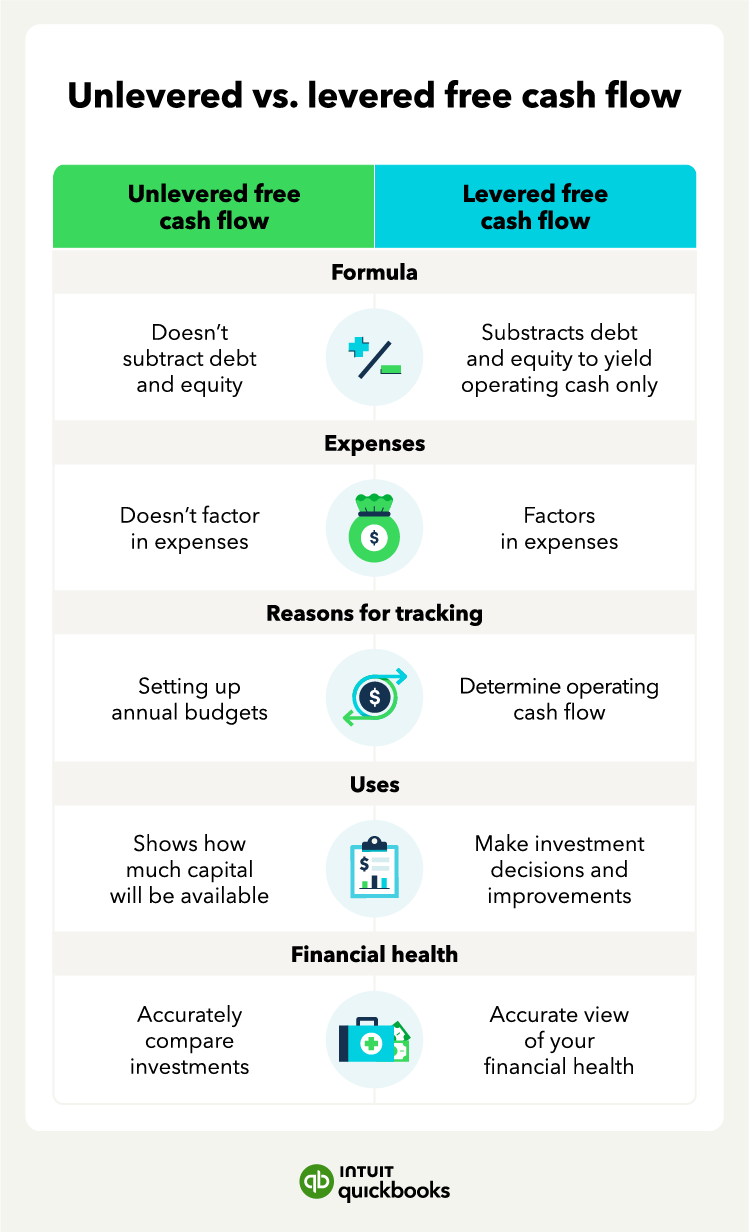Formulas
The first difference between unlevered vs. levered free cash flow is the formula. The equation for levered free cash flows is:
LFCF = EBITDA – change in net working capital – CAPEX – mandatory debt payments
The formula for unlevered free cash flow is:
UFCF = EBITDA – CAPEX – working capital – taxes
In these formulas, EBITDA represents your company’s “Earnings Before Interest, Taxes, Depreciation,” and CAPEX represents your capital expenditures, which is the money used to fund daily business activities.
As you can see, the equation for unlevered free cash flow is less extensive than the one for levered free cash flow. That’s because the levered free cash flows equation subtracts debt and equity to yield operating cash only, while unlevered free cash flows do not.
So, how does this change for startups, small businesses, and investors?
For startups, they usually depend on outside funding and may not generate much revenue in the early stages. That’s why UFCF is key — it shows your business’s core profitability before debt payments. Even if your startup has negative UFCF due to high startup costs, knowing how to calculate unlevered free cash flow for startups can help you explain your company’s potential to investors.
For small businesses, they focus on staying financially stable and paying their bills. In this case, LFCF is important because it shows how much cash is left after covering all expenses, including debt payments. For example, businesses with equipment loans or property debt must calculate LFCF to ensure they’re not overspending and can meet financial obligations.
When it comes to levered vs. unlevered cash flow for investors, they look at both to judge a company’s financial health.
- UFCF: They use it to value a business as a whole since it excludes debt.
- LFCF: They use it to focus on equity value and how debt impacts cash flow.
Expenses
One of the main differences between levered and unlevered free cash flow is how they treat expenses. Levered cash flows factor in expenses, such as operating expenses, debt payments, interest expenses, and taxes.
In contrast, unlevered cash flows do not factor them in. Essentially, unlevered free cash flows are what you have before expenses and levered cash flows are what you have after.
Reasons for tracking
So why should you track levered and unlevered free cash flows? Here are a few reasons why it matters to keep tabs on these metrics.
- Determine operating cash flow: Levered free cash flow (LFCF) helps businesses with a healthy amount of debt and working capital determine how much operating cash flow is available for expansion.
- Keep an eye on debt impact: LFCF can go negative if your company has significant debt holders. While not ideal, a temporary negative LFCF could just mean you've invested heavily and need time to see returns.
- Improve budgeting and efficiency: Your company can utilize unlevered free cash flows (UFCF) when setting up your annual budgets to determine whether or not your departments are using their funding effectively. If UFCF levels are too low, there’s a good chance your company will fail to satisfy its debts and, in the long run, face bankruptcy.
- Make your business attractive to investors: Your company may track UFCF to paint the business in a better light to shareholders and potential buyers. The firms that carry significant debt tend to report unlevered cash flow instead of levered cash flow. As a result, your company may appear more successful and solvent than it truly is, demonstrating a higher amount of working capital.
Uses
Unlevered free cash flow is useful for investors and prospective buyers. When investors purchase a company, one of their goals is to pay off debts to enhance the business’s long-term market value. Unlevered free cash flow reveals how much capital will be available after making interest payments and paying down the net debt balance.
Levered free cash flow is also useful for investors and prospective buyers, but instead, they use it to make investment decisions and find ways to make improvements since it shows how much cash your business has to expand. In some ways, levered cash flows are seen as the more reliable method of financial modeling as they are a better indicator of a company’s future profitability.
Here’s an example: Imagine an investor evaluating two tech startups — Company X and Company Y — during an economic downturn, both valued at $10 million.
Company X generates $2 in unlevered free cash flow, while Company Y generates $1.5 million in unlevered free cash flow. At first glance, Company X may be more attractive since it generates more cash from its operations ($2 million vs. $1.5 million). However, when looking at the levered free cash flows, the investor sees that Company X has $5 million in debt and Company Y has no debt.
During an economic downturn, the investor may choose Company Y despite its lower UFCF because they have no debt, and all the cash flow is available for reinvestment, savings, or expansion. Company X has a higher UFCF, but its $5 million debt reduces its LFCF. This adds financial risk and leaves less cash available after making mandatory debt payments.
Financial health importance
As you can see, levered free cash flow provides a look at your company's “present value” and an accurate view of your financial health, which allows you to measure your operating income.
Unlevered free cash flows can help with budgeting and forecasting, as it shows the gross cash flow amount. This allows you to better compare the value of different investments and businesses, as some might have a higher interest expense and others don’t.












